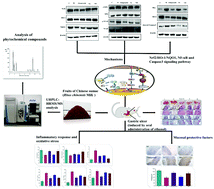Gastroprotective effect and mechanisms of Chinese sumac fruits (Rhus chinensis Mill.) on ethanol-induced gastric ulcers in mice†
Abstract
This paper aimed to study the effect of the phenol-rich fraction from Chinese sumac fruits on ethanol-induced gastric ulcers in mice and to further elucidate the potential mechanisms. The results showed that the phenol-rich fraction of the fruits significantly decreased the ulcer index, restored the levels of prostaglandin E-2, heat shock protein 70, glutathione and superoxide dismutase, and reduced the malondialdehyde content. Further analyses revealed that the fraction significantly alleviated the gastric oxidative stress by upregulating the Nrf2 protein pathway to increase the HO-1 and NQO1 expression levels, suppressed the inflammation by reducing the expression levels of p-NF-κB and p-IκBα and inhibited the secretion of tumor necrosis factor-α, interleukin-1β, and interleukin-6. In addition, the fraction remarkably prevented gastric mucous cell apoptosis by upregulating Bcl-2 and downregulating Bax and cleaved caspase3. This experiment clarified for the first time that the phenol-rich fraction from Chinese sumac fruits can prevent ethanol-induced gastric ulcers in mice by inhibiting the oxidative stress, inflammatory response and cell apoptosis. The results obtained from the current work indicated that the phenol-rich fraction from Chinese sumac fruits could be applied as a kind of natural resource for producing new functional foods to prevent and/or improve gastric ulcers induced by ethanol.



 Please wait while we load your content...
Please wait while we load your content...